2010 Sea-Doo ADVANCED TEC iCATCH I Trailer Review
Making a better trailer
In the purchase of a PWC, the trailer is usually an afterthought. It’s a purely functional piece of equipment, a tool to get your toy to the water and home again, nothing more. Extravagances are limited to the occasional custom paint job. Virtually no one, however, has attempted to improve upon the basic concept of a frame, bunks, and two wheels to move it down the highway.
Leave it to Sea-Doo to be the first. Why? Turns out the trailer market is rather substantial. This could be dismissed as just another way to increase profits. But in typical Sea-Doo fashion, company engineers also actually have the gall to think they can make a better mousetrap.
I headed to the nearest ramp to see if they were right.
It’s Catchy
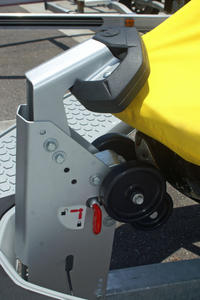 Instead of using a winch, you just ride up the ramp and lock into the iCATCH mechanism.
Instead of using a winch, you just ride up the ramp and lock into the iCATCH mechanism.Look at the ADVANCED TEC iCATCH I trailer (couldn’t anyone have shortened that name?) and you’ll immediately notice several things — a swoopy elevated platform that rings the exterior, roller bunks, and the distinct absence of a winch at what has become known as the “winch post.” The form is actually kind of Sea-Doo sexy, and all with appropriate function.
First, the elevated platform. It gives the trailer its unique style, but is designed to allow the rider access to the craft from virtually all sides. The nonslip surface provides a sure footing. The platform dips at the front to make it easier to step up from the ground. An overlooked feature is that it also makes the trailer easier to see from the car when backing an empty trailer into the water.
That walkway also doubles as an alignment guide. It literally funnels a craft into position, locating it atop the rollers (you don’t see those too often on a PWC trailer), and guiding the bow toward the third piece of the puzzle, the winch-less winch post.
Here’s where the magic of the iCATCH is truly revealed. Drive the craft forward and the bow eye contacts the iCATCH mechanism, a spring-loaded arm that grasps the eye upon contact. That’s all there is to it. The driver of the PWC can then just walk off the boat.
Launching promises to be equally efficient. A release handle is located within arm’s reach of a seated driver. Pull it and the iCATCH mechanism releases, allowing the craft on the trailer to simply roll away.
But Does It Work?
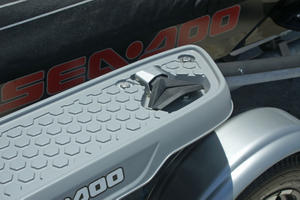 To unhook the PWC from the trailer, just pull the release handle on the left side.
To unhook the PWC from the trailer, just pull the release handle on the left side.The answer is yes, and quite well. I hopped aboard the trailer easily at the launch ramp. Sea-Doo’s design doesn’t require the tow vehicle to be backed into the water, so it stays dry. The walk platform proved solid, allowing me to stroll along and hop into position. Once comfortably on the seat, I reached over with my left hand and pulled the release. A notable clunk of the mechanism later I was rolling off the trailer into the water.
When it came time to pull onto the trailer, I purposely came in as crooked as possible. As promised, the walkway guided the boat into position. As I moved forward, the iCATCH mechanism latched on with authority. To be honest, I expected a few misfires. Through numerous tries, however, it caught every time. As I walked off, I flipped a security lever to prevent anything from accidentally releasing. Very cool. Once out on the road, Sea-Doo’s torsion axles also offered a nice, smooth ride.
Price Of Admission
But is all this convenience worth Sea-Doo’s $1,399 asking price…that’s the big question. Basic trailers can be had for much less. In fact, Sea-Doo is making a basic trailer as well, without the iCATCH mechanism and rollers, for $799. Unless I had a pretty fat wallet, I’d probably hesitate.
Leave it to my wife, however, to offer the opposing point of view. As she noted, many women — and men — find the launch ramp experience intimidating. The iCATCH reduces it to a pretty simple process, eliminating that stress. It’s especially easy if you’re riding solo and don’t have an extra hand to help.
But what about the substantial premium? Again, she makes a good argument. PWC buyers are already spending a substantial amount on their craft. Figuring you’ll use the boat for 5-10 years, what’s a little extra a year for a stress-free situation every time you use the ramp?
My only remaining concern would be how well the cable release mechanism would hold up over time, especially in saltwater. Company insiders tell me prototypes have held up quite well in testing. If I owned one, however, I think I’d use liberal doses of a rust-prevention spray, and monitor the cable at regular intervals.
So would I buy one? That’s not the question. It’s would you?
| ADVANCED TEC iCATCH I Specs | |
| Overall Length | 13′ 6″ |
| Overall Width | 5′ 10″ |
| Maximum PWC Width | 4′ 3″ |
| Coupler | 2.0″ |
| Weight (Approximate) | 360 lbs |
| Carrying Capacity | 1,200 lbs |
| MSRP | $1,399 |
Get PersonalWatercraft.com in your Inbox!
Like PersonalWatercraft.com on Facebook
Comments
Most Popular

2025 Yamaha JetBlaster PRO 2-Up Review

2024 Kawasaki Jet Ski STX 160X Review

Remembering the Sea-Doo XP

Whatever Happened to the Wetbike?

2025 Yamaha JetBlaster Review




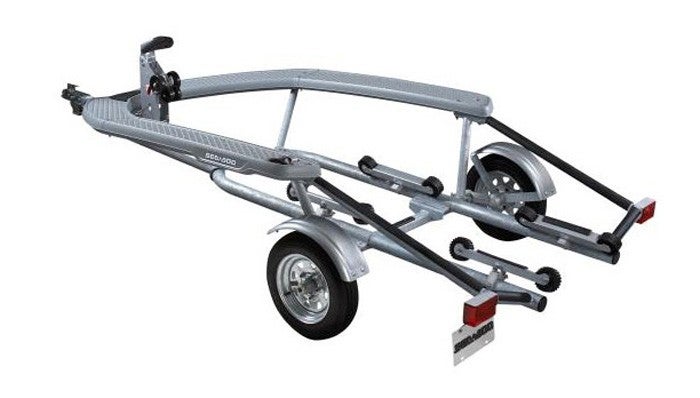
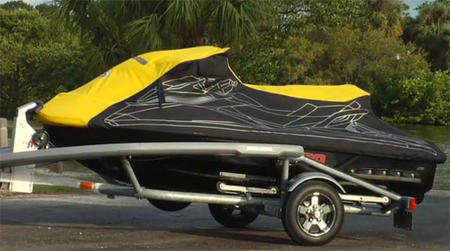 Sea-Doo’s new ADVANCED TECH iCATCH 1 trailer.
Sea-Doo’s new ADVANCED TECH iCATCH 1 trailer.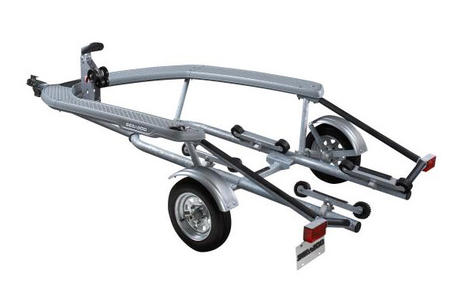 At $1,399, the ADVANCED TECH iCATCH 1 will cost you hundreds more than a traditional PWC trailer.
At $1,399, the ADVANCED TECH iCATCH 1 will cost you hundreds more than a traditional PWC trailer.








 Your Privacy Choices
Your Privacy Choices